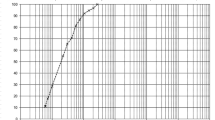Abstract
Utilisation of locally available marginal soil as a construction material is one wise choice when improve its characteristics. Foundry sand (FS) is an industrial by-product obtained from foundry industries. In the present project, an attempt has been made to enhance geotechnical characteristics of locally available marginal red soil (RS) by addition of FS in 10%, 30% and 50% to weight of dry soil. Further, the present project intends to blend a strong stabiliser like cement (C) to enhance the strength and durability of mix made with red earth and 30% FS In this regard, 2.5%, 5% and 7.5% of cement is added to above mix. Addition of 5% C mixed with 30% FS has shown unconfined compressive strength (UCS) of 1548.22 kPa. This strength has been achieved even after 12 cycles of alternate wetting–drying of specimens prepared by blending RS + 30%FS + 5%C mix. The addition of 5% C passing the required durability criteria. Moreover, UCS of 3442.02 kPa has been achieved even after 12 cycles of alternate wetting–drying of specimens prepared by blending RS + 30% + 7.5%C. FS is a sustainable material, and it can be used as an alternative to natural river sand for enhancing geotechnical characteristics of RS.













Similar content being viewed by others
References
Baligar, V.C.; Fageria, N.K.; Eswaran, H.; Wilson, M.J.; He, Z.: Nature and properties of red soils of the world. Red Soils China (2004). https://doi.org/10.1007/978-1-4020-2138-1_2
Klinsky, L.M.G.; Fabbri, G.T.P.; dos Bardini, V.S.: Reuse of waste foundry sand mixed with lateritic clayey soils in pavement bases and sub-bases courses. In: Canestrari, F.; Partl, M. (Eds.) 8th RILEM International Symposium on Testing and Characterization of Sustainable and Innovative Bituminous Materials, Vol. 11, pp. 569–582. Springer, Cham (2016). https://doi.org/10.1007/978-94-017-7342-3_46
Goodhue, M.J.; Edil, T.B.; Benson, C.H.: Interaction of foundry sand with geo-synthetics. J. Geotech. Geoenviron. Eng. 127(4), 353–362 (2001). https://doi.org/10.1061/(ASCE)1090-0241(2001)127:4(353)
Arulrajah, A.; Yaghoubi, E.; Imteaz, M.; Horpibulsuk, S.: Recycled waste foundry sand as a sustainable subgrade fill and pipe-bedding. Construction material: engineering and environmental evaluation. Sustain. Cities Soc. 28(1), 343–349 (2017). https://doi.org/10.1016/j.scs.2016.10.009
Yucel, G.; Ahmet, H.A.; Demirkan, M.M.: Geo-environmental behaviour of foundry sand amended mixtures for highway sub bases. Waste Manag. 26(9), 932–945 (2006). https://doi.org/10.1016/j.wasman.2005.06.007
Gedik, A.; Lav, M.A.; Lav, A.H.: Utilization of waste foundry sand as pavement sub-base and fill material. In: Ellis, E.; Yu, H.-S.; McDowell, G.; Dawson, A.R.; Thom, N. (Eds.) Advances in Transportation Geotechnics, pp. 149–147. Taylor & Francis Group, London (2008). https://doi.org/10.1201/9780203885949.ch17
Firoozi, A.A.; Olgun, C.G.; Firoozi, A.A.; Baghini, M.S.: Fundamentals of soil stabilization. Int. J. Geo-Eng. 8, 26 (2017). https://doi.org/10.1186/s,40703-017-0064-9
Harichane, K.; Ghrici, M.; Kenai, S.: Effect of curing time on shear strength of cohesive soils stabilised with combination of lime and natural pozzolana. Int. J. Civil Eng. 9(2), 90–96 (2010)
Medvey, B.; Dobszay, G.: Durability of stabilised earthen constructions: a review. Geotech. Geol. Eng. 38, 2403–2425 (2020). https://doi.org/10.1007/s10706-020-01208-6
Bahar, R.; Benazzoug, M.; Kenai, S.: Performance of compacted cement-stabilised soil. Cement Concr. Compos. 26(7), 811–820 (2004). https://doi.org/10.1016/j.cemconcomp.2004.01.003
Sarkar, R., & Bhowmik, D.: Effect of polypropylene fiber reinforcement on cement stabilization of local red soil in silchar area. Indian Geotechnical Conference GeoNEst-2017 (2017)
Mousavi, S.E.: Stabilization of compacted clay with cement and/or lime containing peat ash. Road Mater. Pavement Des. 18(6), 1304–1321 (2016). https://doi.org/10.1080/14680629.2016.1212729
Nagaraj, H.B.; Sravan, M.V.; Arun, T.G.; Jagadish, K.S.: Role of lime with cement in long-term strength of compressed stabilised earth blocks. Int. J. Sustain. Built Environ. 3(1), 54–61 (2014). https://doi.org/10.1016/j.ijsbe.2014.03.001
Banjo, A.A.; Alhassan, E.; Aladegboye, O.; Denen, T.A.; Owolaja, G.: The use of red earth, lateritic soils and quarry dust as an alternative building material in sandcrete block. Sci. Afr. 7(3), e00263 (2020). https://doi.org/10.1016/j.sciaf.2020.e00263
Sravan, M.V.; Nagaraj, H.B.: Potential use of enzymes in the preparation of compressed stabilised earth blocks. J. Mater. Civ. Eng. (2017). https://doi.org/10.1061/(ASCE)MT.1943-5533.0001947
Bradshaw, S.L.; Benson, C.H.; Olenbush, E.H.; Melton, J.S.: Using foundry sand in green infrastructure construction. Green Str. Highw. (2012). https://doi.org/10.1061/41148(389)24
ASTM D559/D559M-15, Standard test methods for wetting and drying compacted soil-cement mixtures
Amulya, S.; Ravi Shankar, A.U.: Replacement of conventional base course with stabilised lateritic soil using ground granulated blast furnace slag and alkali solution in the flexible pavement construction. Int. J. Geosynth. Ground Eng. 50, 276–288 (2020). https://doi.org/10.1007/s40098-020-00426-2
Bandara, W.W.; Mampearachchi, W.K.; Sampath, K.H.S.M.: Cement stabilised soil as a road base material for use in Sri Lankan roads. Eng. J. Inst. Eng. Sri Lanka 50(1), 21–29 (2017). https://doi.org/10.4038/engineer.v50i1.7241
MORTH.: Specifications for road and bridge works. Ministry of road Transport & Highways, 5th Revision, Indian Roads Congress (2013)
IRC: SP:89. (Part II). Guidelines for the design of stabilised pavements. Indian Roads Congress
Acknowledgements
Authors are highly thankful to Dr. K. Mallikarjuna Rao, Professor, Department of Civil Engineering, SVU College of Engineering, Tirupati, Andhra Pradesh, India for his valuable suggestions. Authors are thankful to Er. Y. Tirumala, PG scholar at VR Siddhartha Engineering College for his constant support during this study.
Funding
No funding received.
Author information
Authors and Affiliations
Corresponding author
Ethics declarations
Conflict of interest
The authors declare that there is no conflict of interest.
Rights and permissions
About this article
Cite this article
Sai Chandu, A., Rama Subba Rao, G.V. Strength and Durability Characteristics of Red Soil Stabilised with Foundry Sand and Cement. Arab J Sci Eng 46, 5171–5178 (2021). https://doi.org/10.1007/s13369-021-05423-y
Received:
Accepted:
Published:
Issue Date:
DOI: https://doi.org/10.1007/s13369-021-05423-y




